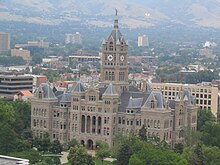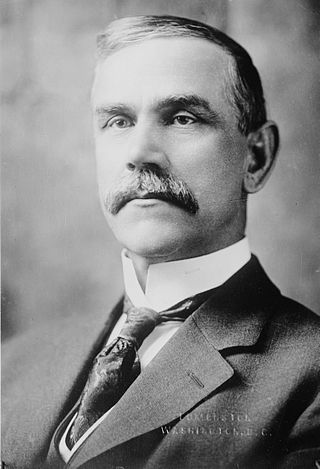
Reed Smoot was an American politician, businessman, and apostle of the Church of Jesus Christ of Latter-day Saints. First elected by the Utah State Legislature to the U.S. Senate in 1902, he served as a Republican senator from 1903 to 1933. From his time in the Senate, Smoot is primarily remembered as the co-sponsor of the 1930 Smoot–Hawley Tariff Act, which increased almost 900 American import duties. Criticized at the time as having "intensified nationalism all over the world" by Thomas Lamont of J.P. Morgan & Co., Smoot–Hawley is widely regarded as one of the catalysts for the worsening Great Depression.

The State of Deseret was a proposed state of the United States, promoted by leaders of the Church of Jesus Christ of Latter-day Saints who had founded settlements in what is today the state of Utah. A provisional state government operated for nearly two years in 1849-50, but was never recognized by the United States government. The name Deseret derives from the word for "honeybee" in the Book of Mormon.

The Territory of Utah was an organized incorporated territory of the United States that existed from September 9, 1850, until January 4, 1896, when the final extent of the territory was admitted to the Union as the State of Utah, the 45th state. At its creation, the Territory of Utah included all of the present-day State of Utah, most of the present-day state of Nevada save for Southern Nevada, much of present-day western Colorado, and the extreme southwest corner of present-day Wyoming.
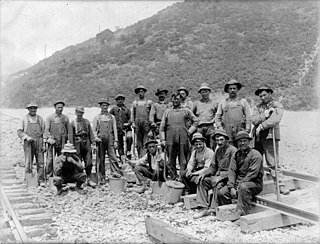
The Liberal Party was a political party established in the latter half of the 1800s in Utah Territory before the national Democrats and Republicans established themselves in Utah in the early 1890s.
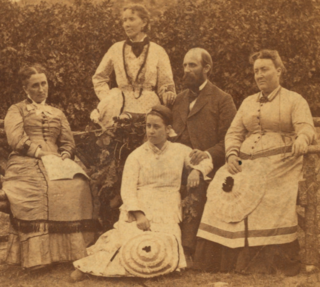
The 1890 Manifesto is a statement which officially advised against any future plural marriage in the Church of Jesus Christ of Latter-day Saints. Issued by Church President Wilford Woodruff in September 1890, the Manifesto was a response to mounting anti-polygamy pressure from the United States Congress, which by 1890 had disincorporated the church, escheated its assets to the U.S. federal government, and imprisoned many prominent polygamist Mormons. Upon its issuance, the LDS Church in conference accepted Woodruff's Manifesto as "authoritative and binding."

Martha Maria "Mattie" Hughes Cannon was a Utah State Senator, physician, Utah women's rights advocate, suffragist, polygamous wife, and a Welsh-born immigrant to the United States. Her family immigrated to the United States as converts to the Church of Jesus Christ of Latter-day Saints and traveled West to settle in Utah territory with other Saints. She started working at the age of fourteen. At sixteen she enrolled in the University of Deseret, now called the University of Utah, receiving a Bachelors in Chemistry. From there she attended the University of Michigan and received her MD. She became the fourth of six wives in a polygamous marriage to Angus M. Cannon, a prominent Latter-day Saint leader during the anti-polygamy crusade. Cannon exiled herself to Europe so she wouldn't have to testify against her husband and others. Upon returning to Utah, Cannon worked as a doctor and fought for women's rights. She helped put women enfranchisement into Utah's constitution when it was granted statehood in 1896. On November 3, 1896 Cannon became the first female State Senator elected in the United States, defeating her own husband, who was also on the ballot. Martha Hughes Cannon was the author of Utah sanitation laws and was a founder and member of Utah's first State Board of Health.

The Edmunds–Tucker Act of 1887 was an Act of Congress that focused on restricting some practices of the Church of Jesus Christ of Latter-day Saints. An amendment to the earlier Edmunds Act, it was passed in response to the dispute between the United States Congress and the LDS Church regarding polygamy. The act is found in US Code Title 48 & 1461, full text as 24 Stat. 635, with this annotation to be interpreted as Volume 24, page 635 of United States Statutes at Large. The act is named after its congressional sponsors, Senator George F. Edmunds of Vermont and Congressman John Randolph Tucker of Virginia.

The Utah State Legislature is the state legislature of the U.S. state of Utah. It is a bicameral body, comprising the Utah House of Representatives, with 75 state representatives, and the Utah Senate, with 29 state senators. There are no term limits for either chamber.

Emmeline Blanche Woodward Harris Whitney Wells was an American journalist, editor, poet, women's rights advocate, and diarist. She served as the fifth Relief Society General President of the Church of Jesus Christ of Latter-day Saints from 1910 until her death. She represented the state of Utah at both the National and American Women's Suffrage conventions and was president of the Utah Woman's Suffrage Association. She was the editor of the Woman's Exponent for 37 years. She was a plural wife to Newel K. Whitney, then Daniel H. Wells.

The Utah Republican Party is the affiliate of the Republican Party in the U.S. state of Utah. It is currently the dominant party in the state, and has been for almost all of its history, controlling all four of Utah's U.S. House seats, both U.S. Senate seats, the governorship, and has supermajorities in both houses of the state legislature.

The History of Utah is an examination of the human history and social activity within the state of Utah located in the western United States.

The Edmunds Act, also known as the Edmunds Anti-Polygamy Act of 1882, is a United States federal statute, signed into law on March 23, 1882 by President Chester A. Arthur, declaring polygamy a felony in federal territories, punishable by "a fine of not more than five hundred dollars and by imprisonment for a term of not more than five years". The act is named for U.S. Senator George F. Edmunds of Vermont. The Edmunds Act also prohibited "bigamous" or "unlawful cohabitation", thus removing the need to prove that actual marriages had occurred. The act not only reinforced the 1862 Morrill Anti-Bigamy Act but also made the offense of unlawful cohabitation much easier to prove than polygamy misdemeanor and made it illegal for polygamists or cohabitants to vote, hold public office, or serve on juries in federal territories.

Women's suffrage was first granted in Utah in 1870, in the pre-federal period, decades before statehood. Among all U.S. states, only Wyoming granted suffrage to women earlier than Utah. Because Utah held two elections before Wyoming, Utah women were the first women to cast ballots in the United States after the start of the suffrage movement. However, in 1887 the Edmunds–Tucker Act was passed by Congress in an effort to curtail Mormon influence in the territorial government, disallowing the enfranchisement of the women residents within Utah Territory. Women regained the vote upon Utah statehood in 1896, when lawmakers included the right in the state constitution.

Franklin Snyder Richards was the general counsel for the Church of Jesus Christ of Latter-day Saints in the late-19th and early-20th century. He was closely connected with the defense against charges of polygamy of many leading LDS Church figures.

Emily Sophia Tanner Richards was a key figure in the founding of the Utah Woman's Suffrage Association.
Christian Nielsen Lund was a Mormon pioneer and a member of the Utah Territorial Legislature.

Early in its history, the Church of Jesus Christ of Latter-day Saints had a series of negative encounters with the federal government of the United States. This led to decades of mistrust, armed conflict, and the eventual disincorporation of the church by an act of the United States Congress. The relationship between the church and the government eventually improved, and in recent times LDS Church members have served in leadership positions in Congress and held other important political offices. The LDS Church becomes involved in political matters if it perceives that there is a moral issue at stake and wields considerable influence on a national level with over a dozen members of Congress having membership in the church in the early 2000s, and about 80% of Utah state lawmakers identifying as LDS.
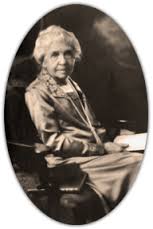
Jennie Anderson Froiseth was the founder of the Blue Tea, a literary club for women who were not Mormon in Utah Territory. The Blue Tea would later change its name to the Ladies Literary Club. She was an anti-polygamy crusader who helped form and was the vice president of the Anti-Polygamy Society of Utah. Froiseth published the Anti-Polygamy Standard which lasted three years and later edited The Women of Mormonism, a book which described in detail the experiences of some Mormon women inside polygamous marriages. She believed strongly in women's rights and played a role in bringing enfranchisement to Utah Territory, later she became the vice president of the Utah Women's Suffrage Association. Although a strong supporter of female suffrage, she believed Mormon women should not have the right to vote until polygamy was eradicated.

Charlotte Ives Cobb Kirby was an influential and radical women's rights activist and temperance advocate in the state of Utah as well as a well-known national figure. Charlotte was born in Massachusetts and at seven years of age moved to Nauvoo, Illinois with her mother, an early member of the Church of Jesus Christ of Latter-day Saints. There, without divorcing father Henry Cobb, her mother became Brigham Young's second plural wife. They then moved to Utah in 1848. Charlotte, previously a plural wife herself, spoke out against polygamy and gained much opposition from polygamous women suffragists because of it. Her first marriage was to William S. Godbe, the leader of the Godbeite offshoot from the LDS Church. After divorcing Godbe, Kirby married John Kirby, a non-LDS man, and they were together until Charlotte's death in 1908. Charlotte was a leading figure of the Utah Territory Woman Suffrage Association, and served as a correspondent to the government and other suffragist organizations, including the National Women's Suffrage Association. Charlotte often traveled to the East Coast to deliver lectures regarding women's rights and temperance, the first Utah woman and the first woman with voting rights to speak to national suffragist audiences. Charlotte Ives Cobb Kirby died on January 24, 1908, at age 71 in Salt Lake City, Utah.
The Twin Relics of Barbarism refer to the popular nineteenth-century phrase that linked the practices of slavery and polygamy in the United States. Attention to these twin relics increased following the 1856 Republican National Convention as the party acknowledged both practices in their party platform. Within the party's planks, they called on Congress to firmly denounce the "twin relics of barbarism –– Polygamy and Slavery." During this period, slavery was widely practiced among southern states, and polygamy was becoming prevalent among members of the Church of Jesus Christ of Latter-day Saints. The growth of these practices stoked fear and uncertainty in the nation at large as the two practices were seen as "incongruous with the pure and the free, the just and safe principles inaugurated by the [American] Revolution." As a result of the widespread opposition to each, they were increasingly coupled together in national print media throughout the country.


